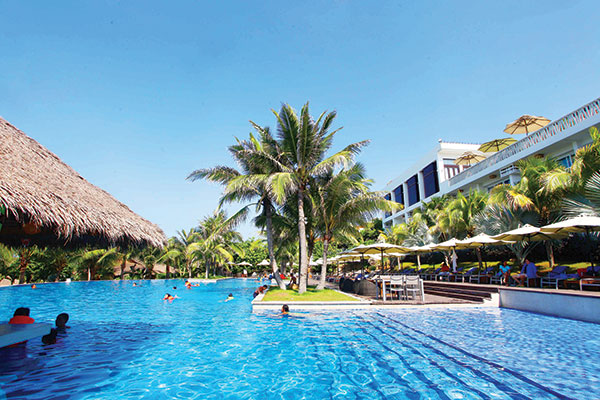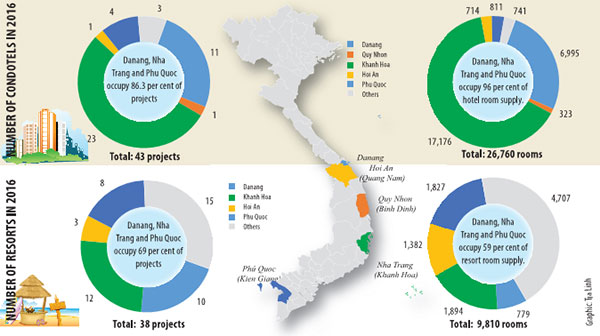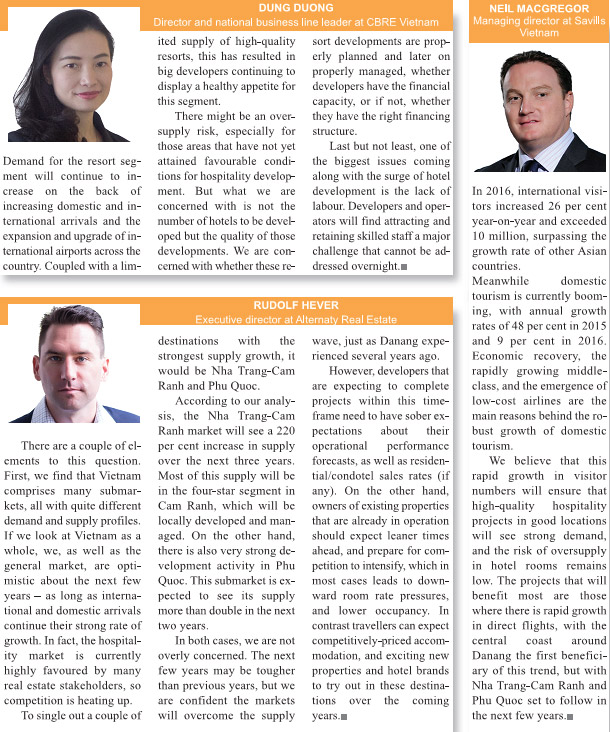Hotel oversupply perils overblown
 |
| Compared to other international destinations, Vietnam’s vacation market is yet to reach its peak Photo: Le Toan |
Increasing supply
The resort segment boomed in 2015 and 2016 with domestic developing giants such as Vingroup, Sun Group, and FLC Group leading the charge. These major projects have been established in high potential destinations like Phu Quoc, Danang, Nha Trang, Quang Ninh, Quy Nhon, and Sapa.
In 2016, FLC Group supplied the market with around 1,000 second home units and beach villas in Thanh Hoa, Quy Nhon, and Halong Bay. Vingroup has added more than 3,000 condotel units and hundreds of beach villas.
While Vingroup is leading in the number of units available at traditional destinations such as Phu Quoc, Nha Trang, and Danang, FLC Group is expanding their portfolios to other highly potential tourism destinations such as Thanh Hoa, Quy Nhon, and Halong Bay.
Sun Group, meanwhile, invested into leisure and entertainment facilities containing high-end villas such as Ba Na Hill, Asia Park, and Fantasy Park, all located near Danang, and Sun World Halong Park, found close to Halong Bay.
On Phu Quoc island, Sun Group has been dominating with more than 650 condotel and villa units valued at $1-1.5 million each.
Other groups have also laid groundwork on major development projects such as CEO Group, BIM Group, and Empire Group.
Professor Dang Hung Vo, former Deputy Minister of Natural Resources and Environment, said, “The winners in the real estate market in the past few years are the investors in the resort segment, which is estimated to be worth as much as 500 tonnes of gold.”
Threat of a resort surplus
At a recent seminar on the second-home market held in Hanoi, Minister of Construction Pham Hong Ha warned that there may be an oversupply of high-end resorts and second-home villas on the market.
“According to our ministry’s figures, there are currently thousands of unsold products in stock, not including the thousands of units that are in the pipeline in the coming years,” Ha said.
The Ministry of Construction is setting up a plan to review the development of the resort and second home market in order to ensure this market develops in a sustainable way.
“We are discussing with related bodies to issue tighter measures on the high-end second home and resort market in order to avoid the uncontrolled development of this segment at the locality in the coming time,” said Ha.
 |
Optimism from developers
Trinh Van Quyet, chairman of FLC Group, said that the resort and second-home market from the mountainous to coastal provinces of Vietnam has seen growth in 2016, with absorption of up to 80 per cent in many projects.
“There might be a threat of oversupply in the coming time, but this segment still has more room to grow,” he said.
Quyet noted that around 10 years ago, most people considered travelling as a luxury. However, since the 2000s, demand has increased sharply. “The reality is that FLC’s hotels and resorts were fully occupied during the hot seasons, and the same situation could be seen in facilities as well.”
Quyet stated that increasing incomes, more young people travelling and spending, and globalisation have opened more opportunities for the development of the resort and second-home segment in Vietnam.
“Compared to neighbouring countries such as Thailand, we can see that Vietnam’s resort development has not yet matured, and there is still more room for development,” Quyet said.
For a price comparison, the average tourist staying at a resort in Vietnam pays $106 per day, while in Thailand the average tourist staying in similar style pays $160 per day.
“Given that more than 10 million international tourists and several million domestic travellers visit the country, if these people paid the same amount as in Thailand, then Vietnam would gain billions of dollars per year,” he added.
Nguyen Duc Chi, general director of the Champarama Resort & Spa in Nha Trang, also agreed that market saturation is not likely.
For example, the Turkish resort city of Antalya receives 12.5 million tourists per year and has more than 1,125 high-end hotels. Nha Trang has a target of hosting seven million tourists by 2020, and will need to increase to at least double its current 11,000 hotel rooms by then.
“In general, Khanh Hoa province and specifically Nha Trang lack in high-end hotels and resorts, as well as other leisure and conference facilities. This shortage cannot be solved in the next few years,” Chi told VIR.
For other locations, Chi said that an oversupply can occur when the developers cannot offer unique and suitable amenities with their projects. “The important thing is how the developers design their products so that they interest both tourists and property buyers,” he said.
According to figures released by the G5 Real Estate Association, more than 17,000 condotels and beach villas were sold in 2016 from more than 40 projects nationwide.
Phuoc Vo, director of valuation and research at Cushman & Wakefield Vietnam, said that there are more and more property projects which have committed to generating increased profit in the market, which gives them an advantage over other investment channels which are not as attractive or have potential risks.
“Deposit interest rates tend to decrease, gold prices fluctuate, and the stock market is for people who have a certain level of understanding. Profit commitments will help the hotel and resort real estate become one of the safest investment channels, and it is easy to approach. As a result, this realty segment has attracted many investors,” Vo said.
Moreover, the increase in tourism is one of the main reasons that many real estate developers have jumped into the resort and second-home segment.
Last year was a bumper year for Vietnam’s tourism sector as the country received a record high of 10 million international visitors, up 26 per cent year-on-year.
The sector contributed more than VND400 trillion ($17.7 billion) to the state budget, according to the Vietnam National Administration of Tourism (VNAT). The figure is equivalent to 8.6 per cent of the country’s $204.7 billion GDP in 2016.
According to VNAT, in order to reach the target of receiving 17-20 million international tourists and 82 million domestic tourists in 2020, hotel and resort facilities must be upgraded. This translates to Vietnam gaining a total turnover from tourism of $35 billion by 2020, which is equivalent to the current turnover of Malaysia, or half of Thailand’s turnover.
This is actually an opportunity for resort developers who are investing in projects in Vietnam.
Towards the future
According to experts, the domestic realty groups will continue developing resorts and second homes, with more players joining the market. International developers such as VinaCapital and Indochina Land have projects in the works to bring super high-end units to the Vietnamese market.
According to Doan Van Binh, deputy chairman of the Vietnam Resort Property Association and chairman of the management board of CEO Group, Vietnamese resort properties are upgrading to international standards.
At the “Vietnam Investment Professional Forum” held recently on Phu Quoc Island, Binh stated the resort market still has potential.
Binh cites three key factors for this potential: Vietnam’s integration to the global economy, which will bring international investors to the country; foreign ownership of property in Vietnam; and most importantly, the increasing income of the Vietnamese people, which has allowed them to travel more.
Ho Vinh Tuan, general director of Tanzanite International, the developer of the $80 million The Hamptons Ho Tram beach resort, said that resort and second-home demand comes from many wealthy locals.
“Resort and second-home properties are bringing stable income flow for the investors, and can be considered a long-term investment,” Tuan said.
Looking forward to 2017, there is plenty of optimism in the hospitality market.
According to a recent report by Savills Vietnam, Hanoi and Ho Chi Minh City are among the markets where villas and townhouses reached the highest number of successful deals in ASEAN in 2015 and 2016, with increasing demand from earners of more than $20,000 per year.
The number of households in Vietnam which have an income of $20,000 per year and upward is predicted to double to 530,000 by 2020, from the current 250,000.
 | |
| Resort segment has room to grow
Vietnamese authorities have recently warned of the possibility of oversupply in the resort and villa segments. Marco Van Aggele, founder and CEO of Fusion Resorts with more than 10 years of experience in resort development in Vietnam, shared an established perspective on the issue. The investment climate in Vietnam is still quite immature compared to some of the surrounding countries. This has resulted in the market going up and down quite quickly. For hospitality, it largely depends on the arrival of flights, which at times seem problematic – at other times the sky seems literally to be the limit. Most of the ‘early birds’ have a hard time breaking the mould, and introducing a new destination to the market is often a big challenge. Compared to other countries, the promotion of tourism to Vietnam is poor. The government will need to work hand-in-hand with investors and operators of hospitality products to carve out a place in such a competitive market. Since the lure of local culture and heritage cannot outweigh places like Bali, Cambodia, and Thailand, the focus should come from the services and experiences that Vietnam can offer: stunning beaches, world-class cuisine, wellness, golf, medical tourism, and facilities well-equipped for MICE (meetings, incentives, conferences, and exhibitions) tourism. However, for this approach to take off, incentives and policies will need to be put into place. In Vietnam, we regularly see the market expand after a good season, and add various copycats to the inventory the subsequent season. However, the moment a certain flow of passengers starts arriving, the market needs to adjust their prices to suit their competition. The opportunity in Vietnam is always to define the next wave of projects. To stand out from the rest – in any investment – it is important to approach a project in a way that its concept will be relevant for the years to come. Phu Quoc, for example, will likely soon face challenges in attracting enough visitors to make this oversupply worthwhile. This magnet for resort and hospitality investment has more than 263 projects in the pipeline. There is something romantic about small islands that has always fascinated people from around the world. Bali and Phuket are just two regional examples where tourism has successfully developed. Phu Quoc could follow in their footsteps if properly guided, but this will need further support from the government, especially in eliminating red tape and increasing promotion for the destination. |
What the stars mean:
★ Poor ★ ★ Promising ★★★ Good ★★★★ Very good ★★★★★ Exceptional
Latest News
More News
- Rare, beautiful, sustainable: the mark of iconic real estate (December 19, 2025 | 08:00)
- Owner-occupied housing stabilises, paving the way for new growth cycle (December 18, 2025 | 17:04)
- Unlocking urban potential of smart cities (December 18, 2025 | 16:50)
- Green finance offers 'passport' for Vietnamese construction, building materials firms (December 15, 2025 | 08:00)
- Gamuda Land commit long-term investment (December 12, 2025 | 11:49)
- HITC ties up with Evolution to develop AI and hyperscale data centres in Vietnam (December 11, 2025 | 12:09)
- Real estate deals boom via high-profile names (December 08, 2025 | 11:32)
- Industrial segment shaped by M&As (December 08, 2025 | 08:00)
- The Privé sets the benchmark for luxury real estate (December 05, 2025 | 08:28)
- TD CASA and the rise of bespoke interior design in luxury living spaces (December 03, 2025 | 14:14)


















 Mobile Version
Mobile Version